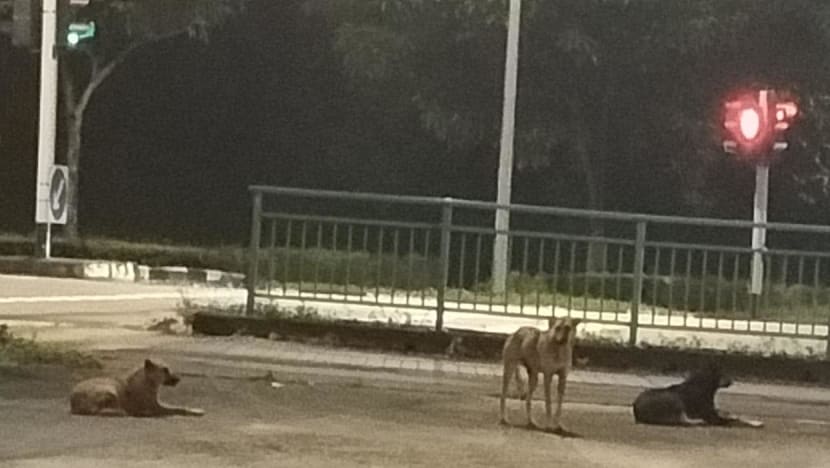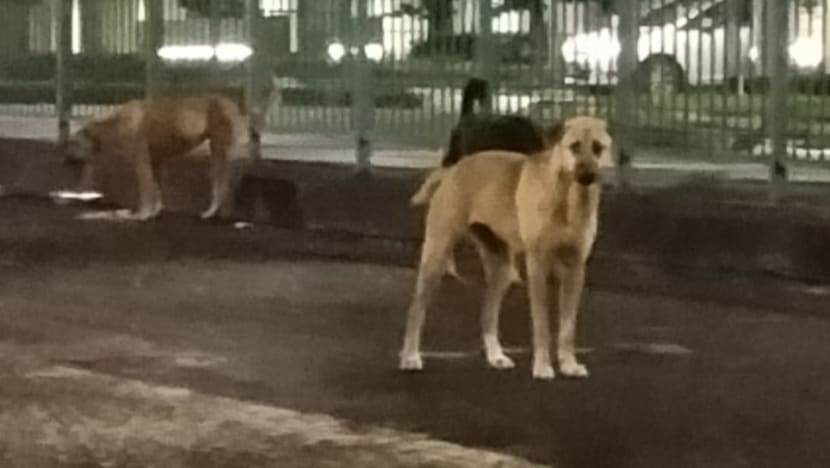'We're exhausted': Cat feeders hope more can be done to stop stray dog attacks
One cat feeder estimates that around 30 community cats have been mauled to death by a pack of stray dogs.

Cat feeder Nisha Kaur has spotted the dogs in Serangoon North, Jalan Kayu and Ang Mo Kio. (Image: Facebook/Nisha Kaur)
SINGAPORE: Cat feeder Nisha Kaur has spent thousands of dollars and hundreds of hours over the past six months trying to protect community cats in Ang Mo Kio and the surrounding areas from stray dogs.
She spends S$1,800 per month paying for boarding for five cats so that they are not on the streets and vulnerable to attacks.
Cat feeders report that a group of dogs has been attacking community cats in recent months, with Ms Kaur, 48, estimating that around 30 cats have been killed. The dogs have shown up in areas such as Ang Mo Kio, Serangoon North and Jalan Kayu.
Besides being on standby to chase the dogs away from community cats, Ms Kaur also prepares food – mostly grilled chicken and dry kibble – for the dogs. She tries to feed them further away from residential areas where the cats are fed, and hopes the dogs can be trapped and rehomed.
In response to queries from CNA, the Animal and Veterinary Service (AVS) said it is aware of the stray dogs at Ang Mo Kio, “including three dogs that have been reported to have attacked some community cats”.
“The dogs were likely originally from a remote site in the north, and could have wandered into Ang Mo Kio,” said Dr Chang Siow Foong, group director of community animal management, AVS.
The AVS, which is under the National Parks Board (NParks), said the dogs in question have been sterilised under the Trap-Neuter-Release-Manage (TNRM) programme. Efforts are made to rehome as many of the sterilised dogs as possible.
“Those that are unable to be rehomed will be released at suitable locations, away from residential estates, to live out their lives naturally,” Dr Chang said.
More than 3,500 stray dogs have been trapped under TNRM since it was launched in 2018, and over 60 per cent were rehomed or fostered, AVS said.
START OF AN ORDEAL
In August last year, Ms Kaur, a paralegal, found one of the community cats that she fed had been attacked.
At the time, she thought it was nature taking its course.
“Sometimes, dogs do pass by a certain area, so maybe they come into contact with a community cat, it’s natural instinct for them to attack. I didn't take it that seriously, honestly, I thought it's just going to be a one-time thing,” Ms Kaur, who heads out most nights to patrol, said.
But two other cats she fed were attacked in September and died from their wounds. In one incident, she said a resident saw the dogs attacking the cat from his home on the third floor but did not take a closer look out of fear.
Another feeder who only wanted to be known as Mrs Ong said she encountered the group of dogs in November when they tried to attack a cat that she was feeding.
“I was nearby then and managed to stop the attack,” she said. But another cat that she fed was killed last month.
“It was around 4am and two kind residents who witnessed the attack tried to help the kitty but it was too late,” said Mrs Ong, 46, who has been feeding community cats for around five years.
Both Ms Kaur and Mrs Ong said they have contacted the authorities regarding the stray dogs, and were told that NParks plans to capture the dogs.
“AVS will work with the community animal caregivers to track and guide the dogs back to their original location through feeding and conditioning. We will monitor the progress closely,” Dr Chang told CNA.
THREAT TO HUMANS?
Mrs Ong said residents told her they have seen the dogs chasing people before, but they generally do not seem aggressive to humans.
Ms Kaur added she has come within 5m to 10m of the dogs when feeding them.
“They are very nice to humans,” she said. “So far they’ve never attacked.”
She believes that the dogs chase cats out of habit and a “natural, typical hunting spirit”.

The AVS said dogs are territorial animals, and may bark when humans or other animals are in their territory or close by.
“Additionally, they may possess an innate instinct to chase and catch things. This behaviour varies in intensity and not all dogs would display such characteristics,” Dr Chang said.
Stray dogs tend to be wary of humans and usually stay out of their way, but may approach and sniff them, he added.
“Members of the public who encounter stray dogs are advised not to stare at them, speak softly and walk away slowly without making any sudden movements.”
The Society for the Prevention of Cruelty to Animals (SPCA) said there have been no known reports of the dogs threatening or attacking humans.
When CNA visited Bishan-Ang Mo Kio Park recently, park users said they were not concerned about the issue of stray dogs in the area.
COMMUNITY EFFORTS
In order to keep community cats safe from the stray dogs, Mrs Ong said more than 20 feeders have been updating each other on sightings of the pack.
“Night patrols (until 5am to 6am at times) are being carried out, with the volunteers forgoing their sleep to save the community cats, not to mention the exhaustion from running around or bicycles patrolling,” she said, adding that some volunteers have stepped up to help the cat feeding community.
The SPCA said members of the public can report sightings of the dogs to help authorities monitor the routes that they take.
“It is important to never approach the dogs or cats and always maintain a safe distance. We kindly request that members of the public refrain from harming the animals,” said Ms Aarthi Sankar, SPCA’s executive director.

The SPCA has established a temporary fostering system, where cat feeders can list their cats for shelter, and members of the public can contact the feeders if they are able to open their homes for at least two months.
Mrs Ong said some cat feeders were quite lucky and found temporary fosterers.
But Ms Kaur said there are limitations to these efforts.
“Some cats are feral cats, that means you can feed them, you cannot touch them. And to bring back home all the cats is not practical,” she said, adding that there are too many cats that need shelter.
HOPES FOR RESOLUTION
A cat feeder who wanted to be known as Ms Sarah said she hopes the dog welfare groups in Singapore can step up to resolve the issue.
“None of them can help,” said the 38-year-old who works in retail. “Their feedback is, ‘our space is full’ or ‘not under our area’.”
Ms Kaur suggested that the authorities can be on standby mode for a short period of time so that the stray dogs can be successfully trapped.
She said there was a night when she found the dogs sleeping peacefully, but did not have the equipment or materials to nab them. If there are officers on standby overnight and work towards a deadline, it may be that the dogs can be trapped more quickly, she said.
“They can do better,” she said. “They are doing their best, but (can be) a little bit more proactive.”
“We are dying here,” she said of the cat-feeding community. “We’re exhausted, we’re drained, mentally, emotionally and physically.”














